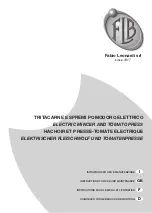
the oven. Always use suitable, heat-resistant
oven gloves to avoid injury. Only carry the
roasting pan using the handles, and be careful
not to touch anybody else with the hot pan.
• Never heat an empty roasting pan, and ensure
that the liquid from cooked food never com-
pletely evaporates. Failure to do so can result in
the food being burned, or cause damage to the
roasting pan or heat source.
• Avoid immersing hot glass lids in water or plac-
ing them on cold surfaces.
• Always hold the lid at the handle when remov-
ing. Never open the lid to the side or towards
your body. The steam should always escape away
from the body!
• Never leave the hot roasting pan unattended.
• Only ever place the hot roasting pan on heat-re-
sistant surfaces.
• Never extinguish burning fat with water. If possi-
ble, use a fire extinguisher to extinguish the flames
or cover with a wet tablecloth in an emergency.
Other notes and tips for use
• Only use the maximum heating level for boiling
or browning. Then turn the heat back down to a
medium or low setting.
• Use a low heat particularly when cooking with
very little water.
• If the lid is well positioned, it may stick due to
the vacuum that is created when cooling down.
In this case, reheat the roasting pan briefly until
the lid becomes free again.
• Do not knock spoons or other kitchen utensils
against the pouring rim. This could damage the
rim.
• Do not touch the surface of the hob immedi-
ately after boiling or frying. This also applies to
induction hobs.
Temperature specifications when using in the
oven
The maximum heat supply depends on the parts with
the lowest temperature resistance (handles or lid).
Never use the oven’s grill function with glass lids.
Roasting pan: 450°
Silicone lid with glass: 180°
Cleaning and care instructions
• After use, rinse with hot water as soon as
possible.
• Should food burn and stick despite taking the
proper precautions, remove blackened residues
immediately. To do so, bring a little water and
cleaning product to the boil in the roasting pan,
remove from the hob, allow any stubborn food
Roasting pan with glass lid
Congratulations on your purchase! You have chosen
a quality product from WMF. High-quality materials,
excellent workmanship and meticulous quality con-
trols ensure a very long service life. The sophisticat-
ed design and well thought-out functionality make
the products extremely practical.
Fusiontec from WMF combines the speed of copper,
the heat-retention capacity of cast iron, the scratch
resistance of glass, the corrosion resistance of
stainless steel and the even frying results of alumini-
um – all in one unique material. The result: rapid
heating, excellent heat distribution and retention
for energy-saving cooking and flawless frying and
cooking results. The extremely hard surface has a
robust finish and is scratch and abrasion resistant,
exceptionally durable and dishwasher-safe – and all
of this with stylish aesthetics and beauty that will
last for many years.
Quality features
• Fusiontec material - made in Germany
• Non-porous closed surface
• Cut-resistant and non-abrasive
• Excellent heat conduction and retention
• Heat resistant up to 450°
• Suitable for all kinds of hobs, including induc-
tion hobs
• Perfect for flash frying
• Wide grip edge
• See-through glass and silicone cooking lid with
heat-insulating hollow handle made of Cro-
margan®
• Easy to clean and hard-wearing if the following
instructions are observed
Please read all of the following instructions
carefully before using this product for the first
time.
Steps before using for the first time
• Remove all stickers before using for the first
time.
• Fill the roasting pan 2/3 with water, add 2-3
tablespoons of vinegar and then boil the vinegar
solution for 5-10 minutes.
• Once cool, rinse all of the parts thoroughly by
hand and carefully dry the roasting pan and lid.
Instructions for safe use
• Please note that Fusiontec is an excellent con-
ductor of heat and that the surfaces therefore
get very hot after a short time when cooking
and frying on the hob as well as when used in
EN
8
9






































